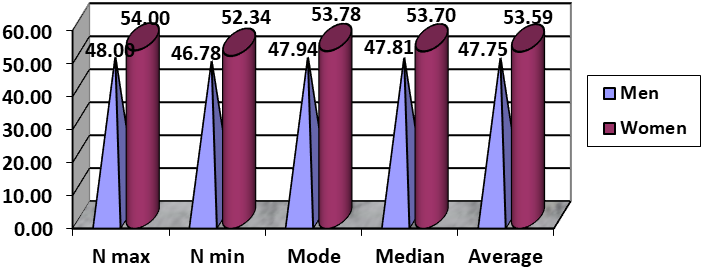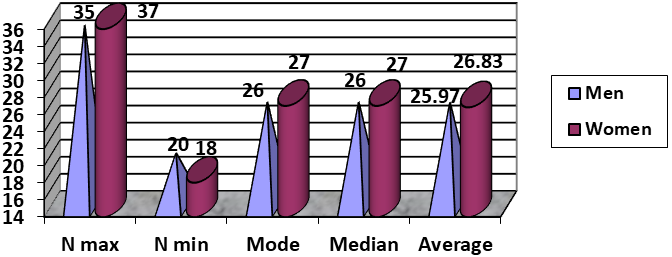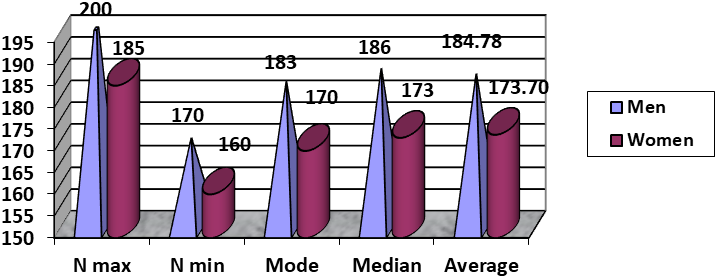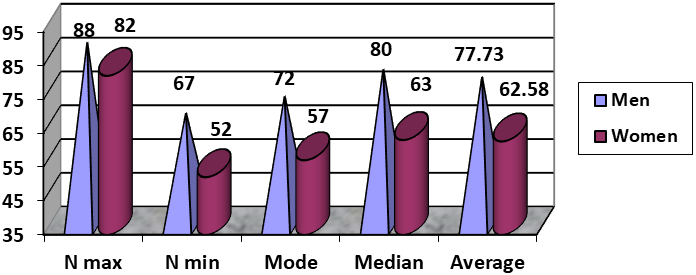Abstract
The work is part of a series of studies, which we have been doing for years on high-performance athletes, with a view to establishing a premier model on event. A review of the best performances in the world, in our opinion is welcome for making up the national team. We proposed in this research to observe the dynamics of the parameters mentioned below, worthy of being taken into account in the selection of athletes. The paper aims at extracting essential data for the selection and preparation of high performance athletes in anticipation of major international competitions. As objectives, we set: the study of bibliography; the collection and tabulation of the following parameters: the performance of the best athletes of all time, their age, height and weight; processing the above-mentioned statistical and mathematical data regarding the following indicators: number of cases, percentage, average, median, mode, range of motion, standard deviation, coefficient of variation, coefficient of correlation; evaluation of the results and their interpretation.
Keywords: Athletes400 m hurdleshigh performancestatistics
Introduction
An overview of global athletes at the middle of the Olympic period, is welcome, as it helps in detaching certain key elements in the selection and preparation of our athletes. In evaluating athletes we must always take into account two fundamental components of human performance in general: the biological and psychological.
The research is part of a study on sports performance, measurement and evaluation. It is a transverse type because the collected results were obtained by 31 July 2018. A review of the best performances in the world, in our opinion is welcome for making up the national team. We proposed in this research to observe the dynamics of the parameters mentioned below, worthy of being taken into account in the selection of athletes.
As objectives, we set: the study of bibliography; the collection and tabulation of the following parameters: the performance of the best athletes of all time, their age, height and weight; processing the above-mentioned statistical and mathematical data regarding the following indicators: number of cases, percentage, average, median, mode, range of motion, standard deviation, coefficient of variation, coefficient of correlation; evaluation of the results and their interpretation (Cărbunaru, 2009, p. 58-79).
Problem Statement
As a general definition, we can say that the performance is "the result of human action superior to known results” (Țifrea, 2002, p. 25).
It is obvious that the main objectives of the training are participating in competitions, challenge other athletes in the competition for a place in the hierarchy of sports and achieve high performance. However, the importance of the competitions passing of these purposes, because they are the most important and specific methods of estimation the progress of athlete (Bompa, 2001, p. 258).
In evaluating athletes we must always take into account two fundamental components of human performance in general: the biological and psychological. In this way the body composition corresponds to the structural components of the human body composed of elements of very different nature and density (bone, fat, water, protein), maintained in constant proportion and functionally integrated (Cordun, 2011, p. 87-110). In this way the precise knowledge of the athlete’s height and weight and is welcome framing it in a test pattern.
Many times in the sport’s practice, while coaches respected the specific training method’s guideline, worked with athletes selected by the constitutional model, they did not achieved the expected performance, because they neglected psychological component. The goal of mental preparation for competitions consists in forming for athletes, of a system of attitudes and behavior, with operational and regulative character through which it is flexible and adapts to contest’s situations and opponents actions (Holdevici, Epuran, & Toniţa, 2008, p. 244-270);
Research Questions
What is the average women performances ?
What is the average women somatic characteristics ?
What is the average men performances ?
What is the average men somatic characteristics ?
There's correlation between indicators ?
Purpose of the Study
The paper aims the detachment of essential data for the selection and preparation of high performance athletes in anticipation of major international competitions
Research Methods
As a research method we have used the case study, observation, statistics, mathematics and graphics.
Findings
It has been processed the data of 107 athletes. Following data collection resulted in 825 performances (IAAF, 2018), 825 data on age, 815 data on height and 792 data on weight of 400 m hurdlers
In what follows, we present the 2 tables and 4 graphs representative undertaken research.




- Compared with the 1993 data, the best performance of study is equal to men (46.78 s) and better to women 52.34 s front of 53.17 s (A.N.E.F.S., 1993, 42 p.)
- The number of cases in men (326) is lower than the female (499) with 173.
- The range of motion in results for women (1.66 s) is greater than that of men (1.22 s) with 0.44 s.
- The mode of performances to the men is 47.94 s and for women 53.78 s.
- The median of performances to the men is 47.81 s and for women 53.70 s.
- The average of performances to the men is 47.75 s and for women 53.59 s.
- The middle interval (half of cases) for men is lower than that of women, as follows: 0.29 s between 47.64 s and 47.93 s at the men and 0.45 s between 53.41 s and 53.86 s at the women.
- We have a very good homogeneity both men (0.45%) and women (0.63%).
Statistical indicators of age (table
- Compared with the 1993 data for best performance, age of women in our study is 1 years lower (25 years as compared to 26 years) and for men is equal with 26 years (A.N.E.F.S., 1993)
- The number of cases for women (499) is greater than that of men (326) with 173.
- The range of motion in age for women (19 years) is greater than that for men (15 years) with 4 years.
- The mode and median of age for women (27 years) is greater than that for men (26 years) with 1 year.
- The average of age for women (26.83 years) is greater than that for men (25.97 years) with 0.86 years.
- The middle interval (half of cases) for women is greater than that of men, as follows: 5 years between 24 and 29 years at the women and 4 years between 24 and 28 years at the men.
- We have a low homogeneity both women (12.98%) and men (11.99%).
Statistical indicators of height (table
- Compared with the 1993 data, for the best performance, height of men in our study is 1 cm greater (194 cm as compared to 193 cm) and for women is greater with 10 cm (180 cm as compared to 170 cm). (A.N.E.F.S., 1993)
- The number of cases for women (493) is greater than that of men (322) with 171.
- The range of motion for women (25 cm) is lower than that for men (30 cm) with 5 cm
- The mode of height for women is 170 cm and for men 183 cm
- The median of height for women is 173 cm and for men 186 cm
- The average of height for women is 173.70 cm and for men 184.78 cm
- The middle interval (half of cases) for women is greater than that of men, as follows: 7 cm between 170 cm and 177 cm at the women and 5 cm between 183 cm and 188 cm at the men.
- We have a very good homogeneity both women (2.88%) and men (2.97%).
Statistical indicators of weight (table
- Compared with the 1993 data, for the best performance, weight of men in our study is 2 kg greater (82 kg as compared to 80 kg) and for women is greater with 8 kg (66 kg as compared to 58 kg). (A.N.E.F.S., 1993)
- The number of cases for women (471) is greater than that of men (321) with 150.
- The range of motion for women (30 kg) is greater than that for men (21 kg) with 9 kg.
- The mode of weight for women is 57 kg and for men 72 kg.
- The median of weight for women is 63 kg and for men 80 kg.
- The average of weight for women is 62.58 kg and for men 77.73 kg.
- The middle interval (half of cases) for women is lower than that of men, as follows: 9 kg between 57 kg and 66 kg at the women and 10 kg between 72 kg and 82 kg at the men.
- We have a good homogeneity at women (10.19%) and very good at men (6.62%).
- We have no correlation between the parameters of the investigation.
Conclusion
- The model of performance (the average data) in women is 53.59 s.
- The somatic model (the average data) in women has the following characteristics: age 26.83 years, height 173.70 cm, weight 62.58 kg, body mass index: 360.27 g/cm.
- The model of performance (the average data) in men is 47.75 s.
- The somatic model (the average data) in men has the following characteristics: age 25.97 years, height 184.78 cm, weight: 77.73 kg, body mass index: 420.66 g/cm.
- Is there a lack of correlation between other parameters investigated.
Acknowledgments
Thanks to colleagues who have helped us.
References
- A.N.E.F.S. Catedra de atletism, F.R.A, (1993). Date statistice privind ultimele 8 ediţii ale Jocurilor Olimpice, [Statistical data for the last 8 Olympic Games], f.e., Bucureşti.
- Bompa, T. O. (2001). Teoria şi metodologia antrenamentului sportiv. Periodizarea. [Theory and methodology of sports training. Periodization], Bucureşti: C.N.F.P.A.
- Cărbunaru, A. B. (2009). Statistică. Bazele statisticii. [Statistics. Basics of statistics] Bucureşti: Editura Universitară.
- Cordun, M. (2011). Bioenergetică şi Ergometrie în Sport. [Bioenergy and Ergometry in Sport]. Bucureşti: Editura CD Press.
- Holdevici, I., Epuran, M., & Tonița, F. (2008). Psihologia sportului de performanţă. Teorie şi practică. [Performance sports psychology. Theory and practice]. Bucureşti: Editura FEST.
- IAAF (2018). Retrieved from ( Access 18.06.2018, 12:10) www.iaaf.org
- Sport Reference (2018). Retrieved from (22.07.2018, 16:25) www.sports-reference.com
- Țifrea, C. (2002). Atletism, [Athletics]. București: Editura DARECO.
Copyright information

This work is licensed under a Creative Commons Attribution-NonCommercial-NoDerivatives 4.0 International License.
About this article
Publication Date
15 August 2019
Article Doi
eBook ISBN
978-1-80296-066-2
Publisher
Future Academy
Volume
67
Print ISBN (optional)
-
Edition Number
1st Edition
Pages
1-2235
Subjects
Educational strategies,teacher education, educational policy, organization of education, management of education, teacher training
Cite this article as:
Ivan, P., & Gheorghe*, D. (2019). Study On Top Athletes At 400 M Hurdles. In E. Soare, & C. Langa (Eds.), Education Facing Contemporary World Issues, vol 67. European Proceedings of Social and Behavioural Sciences (pp. 582-588). Future Academy. https://doi.org/10.15405/epsbs.2019.08.03.69
